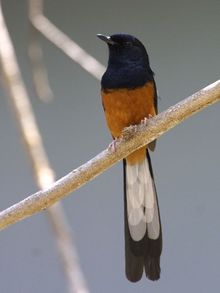- White-rumped Shama
-
White-rumped Shama 
male 
female Conservation status Scientific classification Kingdom: Animalia Phylum: Chordata Class: Aves Order: Passeriformes Family: Muscicapidae Genus: Copsychus Species: C. malabaricus Binomial name Copsychus malabaricus
(Scopoli, 1788)Synonyms Kittacincla macrura
Cittocincla macruraThe White-rumped Shama (Copsychus malabaricus) is a small passerine bird of the family Muscicapidae. It was formerly classified as a member of the Thrush family, Turdidae, causing it to be commonly known as the White-rumped Shama Thrush or simply Shama Thrush.
Contents
Distribution
They are native to South and Southeast Asia, but have been introduced to Kaua'i, Hawai'i, in early 1931 from Malaysia (by Alexander Isenberger), and to O'ahu in 1940 (by the Hui Manu Society).[2] Their popularity as a cage bird has led to many escaped birds establishing themselves. They have been introduced to Taiwan where they are considered an invasive species, eating native insect species and showing aggression towards native bird species.[3]
In Asia, their habitat is dense undergrowth especially in bamboo forests.[4] In Hawaii, they are common in valley forests or on the ridges of the southern Ko'olaus, and tend to nest in undergrowth or low trees of lowland broadleaf forests.[2]
The nominate race is found in the Western Ghats and parts of southern India while leggei is found in Sri Lanka. Race indicus is found in the northern parts of India.[4] Race albiventris is found in the Andaman Islands, interpositus from southwester China to Myanmar, Thailand and the Mergui Archipelago. Southern China has race minor while mallopercnus is found in the Malay peninsula. Race tricolor is found in the Sumatra, Java, Banka, Belitung and Karimata islands. Race mirabilis from the Sunda Strait, melanurus from northwestern Sumatra, opisthopelus, javanus, omissus, ochroptilus, abbotti, eumesus, suavis (Borneo), nigricauda, stricklandii and barbouri are the other island forms. The last two are sometimes regarded as a separate species, the White-crowned Shama (C. stricklandii).
Physical characteristics
They typically weigh between 1 and 1.2 ounces and are around 9 to 11 inches in length. Males are glossy black with a chestnut belly and white feathers on the rump and outer tail. Females are more grayish-brown, and are typically shorter than males. Both sexes have a black bill and pink feet. Juveniles have a more grayish or brownish coloration, similar to that of the females, with a blotchy or spotted chest.
Behaviour
Calls
The white-rumped shama is shy and somewhat crepuscular[4] but very territorial. The territories include a male and female during the breeding season with the males defending the territory averaging 0.09 ha in size,[2] but each sex may have different territories when they are not breeding.
The voice of this species is rich and melodious which made them popular as cage birds in South Asia with the tradition continuing in parts of Southeast Asia. It is loud and clear, with a variety of phrases, and often mimics other birds. They also make a 'Tck' call in alarm or when foraging.[2] One of the first recordings of a bird song that was ever made was of this species. This recording was made in 1889 from a captive individual using an Edison wax cylinder by Ludwig Koch in Germany.[5]
They feed on insects in the wild but in captivity feed on boiled and dried legumes with egg yolk and raw meat.[6]
Breeding
In South Asia, they breed from January to September but mainly in April to June laying a clutch of four or five eggs[7] in a nest placed in the hollow of tree.[4] During courtship, males pursue the female, alight above the female, give a shrill call, and then flick and fan out their tail feathers. It is followed by a rising and falling flight pattern by both sexes. It the male is unsuccessful, the female will threaten the male, gesturing with the mouth open.
The nest is built by the female alone while the male stands guard.[2][8] The nests are mainly made of roots, leaves, ferns, and stems, and incubation lasts between 12 and 15 days and the nestling period averaged 12.4 days. Both adults feed the young although only the female incubates and broods.[2] The eggs are white to light aqua, with variable shades of brown blotching, and are approximately 0.7 by 0.9 inches.
References
- ^ BirdLife International (2006). Copsychus malabaricus. 2006. IUCN Red List of Threatened Species. IUCN 2006. www.iucnredlist.org. Retrieved on 12 May 2006.
- ^ a b c d e f Aguon, Celestino Flores & Sheila Conant (1994) Breeding biology of the white-rumped Shama on Oahu, Hawaii. Wilson Bull. 106(2):311-328 PDF
- ^ Bao-Sen Shieh, Ya-Hui Lin, Tsung-Wei Lee, Chia-Chieh Chang and Kuan-Tzou Cheng (2006) Pet Trade as Sources of Introduced Bird Species in Taiwan. Taiwania, 51(2): 81-86 PDF
- ^ a b c d Rasmussen PC & JC Anderton (2005) Birds of South Asia: The Ripley Guide. Smithsonian Institution & Lynx Edicions. p. 395-396
- ^ Ranft, Richard (2004) Natural sound archives: past, present and future. An. Acad. Bras. Ciênc. 76(2):456-460 doi:10.1590/S0001-37652004000200041
- ^ Jerdon, T. C. (1863) Birds of India. Vol 2. part 1. page 131
- ^ Whistler, H (1949) Popular handbook of Indian birds. Gurney and Jackson. p. 110
- ^ Ali, S. and S. D. Ripley 1973. Handbook of the birds of India and Pakistan. Vol. 8., Oxford Univ. Press, Bombay, India.
External links
- Honolulu Zoo- Information on the White-rumped Shama
- White-rumped Shama videos, photos & sounds on the Internet Bird Collection
- Male shama songs and mimic of sounds
- Shama song
Categories:- IUCN Red List least concern species
- Copsychus
- Birds of Nepal
- Birds of India
- Birds of Bangladesh
- Birds of Sri Lanka
- Invasive animal species
- Birds of Malaysia
- Introduced birds of Hawaii
Wikimedia Foundation. 2010.


